To Lime or Not To Lime
- Jim Wallace

- Jul 15, 2025
- 2 min read
The climate here in Virginia causes most soils to be moderately to strongly acidic, with a pH between 4.5 and 5.5. As soil that is too acidic can be directly toxic to plants, a soil pH that is only slightly acidic (below 7.0, which is neutral) is preferred for most plant species found in agricultural, home garden, and lawn settings. If your soil is too acidic, applying lime will tend to neutralize soil acidity, but how do you ensure that you’re not applying too much or too little? The amount of lime you would need to adjust the soil pH to the target range is dependent on several variables, most importantly—the starting soil pH level and texture. A soil testing laboratory will use this information to calculate the amount of lime that should be applied, as the quantity can vary widely depending on the starting soil’s pH. A recommended application rate may be expressed in ton/acre for agricultural managers or lbs/1,000 ft2 in turf and landscape settings.
We often talk about lime and fertilizer in the same breath and, while it’s common knowledge that the nutrients in fertilizer promote plant growth, many people don’t know why it is important to neutralize soil acidity. Soil pH impacts the amount of nutrients that are available to the plant community, as illustrated in the graphic (Fig. 1). Primary plant nutrients, including nitrogen, phosphorus, and potassium, and the majority of secondary nutrients, including sulfur, calcium, and magnesium, are most available to plants within a pH range of between 6.5 through 7.0. However, within that range, micronutrients, including boron, copper, and zinc, are chemically bound to other molecules in the soil and less available for use by the plants. This means there is a sweet spot along the pH spectrum, generally between 6.2 and 6.5, in which most nutrients are most available to most plant communities. Outside of that sweet spot, the potential exists for plant nutrient deficiencies resulting from high or low soil pH.

What is the best way to determine your soil pH? Take a soil test and send the sample to a soil testing lab for analysis. Luckily, the Virginia Department of Conservation and Recreation, the agency that administers the Virginia Nutrient Management Program, approved these two soil testing labs in Virginia last year:
So reach out, get your soil tested, and find out what it really needs.
Daniels WL, Orndorff Z. Acid Sulfate Soils in Virginia: A Primer. Rehabilitation, Revegetation, Reclamation and Restoration Research. Updated December 2012. https://landrehab.org/wp- content/uploads/2020/01/acid-sulfate-soils-in-virginia_a-primer.pdf
Roques S, Kendall S, Smith KA, Newell Price P, and Berry P. 2013. Review of the non-NPKS nutrient requirements of UK cereals and oilseed rape. Research Review No. 78. HGCA Report.
Read more articles in the Summer 2025 CSWCD Newsletter here.




Comments